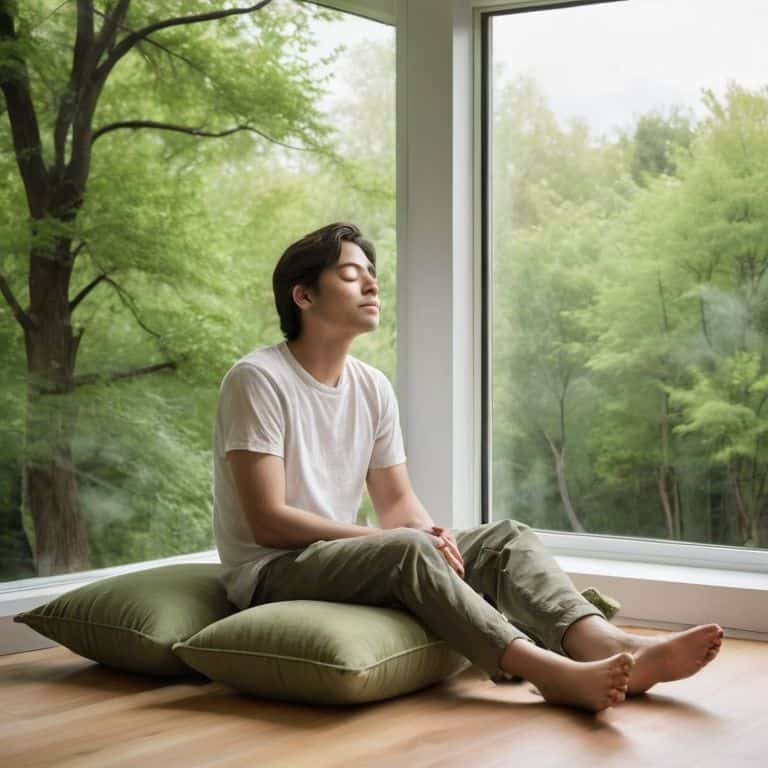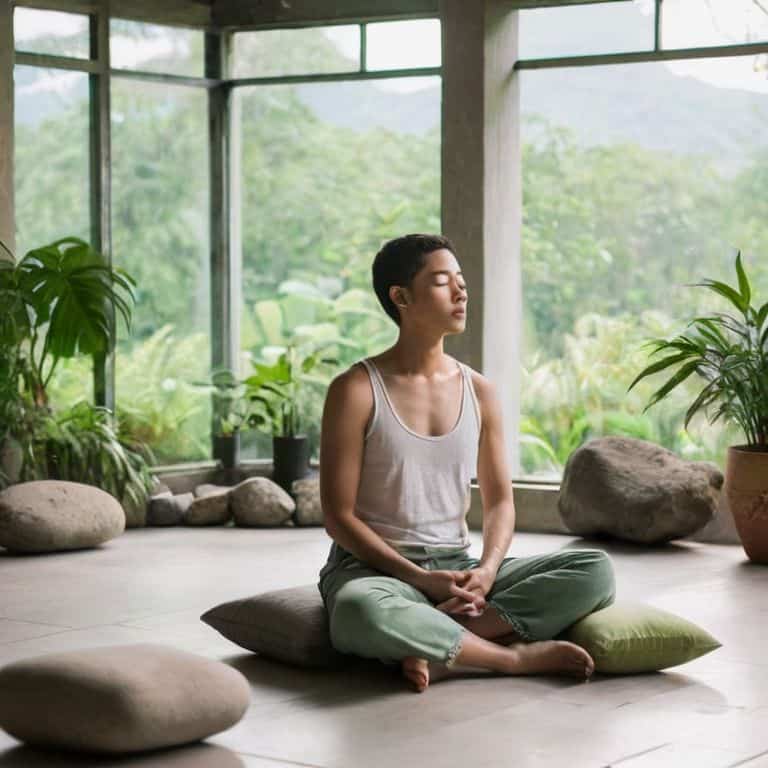To start, take a deep breath in, and as you exhale, allow your gaze to gently focus on the present moment. I’ve found that mindfulness for anxiety is often misunderstood as a complex, esoteric practice, but in reality, it’s a simple, yet powerful tool that can be woven into the fabric of our daily lives. As someone who’s walked the path from a high-stress career to a life of mindfulness, I’ve learned that the greatest myth about mindfulness is that it requires a complete emptying of the mind – a feat that can be daunting, if not impossible, for most of us.
In this guide, I promise to share with you practical, no-nonsense techniques for cultivating mindfulness for anxiety that you can apply in the midst of chaos. You’ll learn how to harness the power of your breath as an anchor to the present, and how to gently bring your attention back to the here and now, without judgment. My goal is to demystify mindfulness and make it an accessible, everyday practice that brings you a sense of inner stillness and peace, no matter what life throws your way.
Table of Contents
Guide Overview: What You'll Need

Total Time: 30 minutes to 1 hour per day
Estimated Cost: $0 – $20
Difficulty Level: Easy
Tools Required
- Smartphone (with meditation app)
- Journal (for recording thoughts and feelings)
Supplies & Materials
- Comfortable seating (e.g., cushion or chair)
- Calming essential oils (optional)
Step-by-Step Instructions
- 1. First, take a deep breath in through your nose, and exhale slowly through your mouth, allowing any tension to release from your body. As you breathe out, feel the weight of your seat on the chair, the sensation of your feet touching the ground, and the sounds around you, letting go of any thoughts or worries.
- 2. Next, find a quiet and comfortable spot to sit, either on a chair or on a cushion on the floor, with your back straight and your body relaxed. Allow your eyes to gently close, and begin to focus on the sensation of the air moving in and out of your nostrils, feeling the gentle caress of each breath.
- 3. Now, bring your attention to the physical sensations in your body, starting from your toes and moving up to the top of your head. As you scan each part of your body, notice any areas of tension or discomfort, and imagine warmth and relaxation spreading through those areas, soothing any tightness or stress.
- 4. As you continue to breathe deeply, introduce a simple mantra to help calm your mind, such as “inhale, exhale” or “breathe in, breathe out.” Repeat this mantra to yourself, allowing it to become a gentle anchor for your attention, guiding you back to the present moment whenever your mind wanders.
- 5. Take a few moments to visualize a peaceful scene, such as a serene beach or a quiet forest, using all of your senses to bring this image to life. Imagine the sounds, smells, and sensations of this peaceful place, allowing yourself to step into this calm environment, leaving any anxiety or worries behind.
- 6. As you sit in stillness, begin to practice loving-kindness meditation, directing kindness and compassion towards yourself and others. Start by repeating simple phrases, such as “May I be happy, may I be healthy, may I be at peace,” and then expand your circle of kindness to include friends, family, and even those you may have difficulty with, cultivating a sense of understanding and empathy.
- 7. Finally, when you are ready to conclude your mindfulness practice, take a few slow, deep breaths, noticing how you feel before slowly opening your eyes. Take a moment to notice the sensations in your body, the sounds around you, and the sense of calm and clarity that has arisen, carrying this feeling with you as you go about your day.
Mindfulness for Anxiety

As I guide you through this journey, I want to remind you to be gentle with yourself. Anxiety can be overwhelming, but it’s essential to approach it with kindness and compassion. One of the most effective anxiety management techniques I’ve found is to focus on the breath. By doing so, we can calm the nervous system and reduce feelings of stress.
When practicing breathing exercises for calmness, it’s crucial to remember that it’s not about achieving a specific state, but rather about being present with what is. Allow yourself to settle into the sensation of the breath moving in and out of the body, and let go of expectations. This simple act can be a powerful catalyst for emotional regulation strategies, helping you navigate life’s challenges with greater ease.
In my experience, combining body scan meditation benefits with mindful breathing can be particularly beneficial for those experiencing anxiety. By cultivating awareness of the body and its sensations, we can begin to release physical tension and promote a sense of calm. Remember to approach these practices with self compassion, acknowledging that it’s okay to feel overwhelmed and that you’re taking steps towards healing and growth.
Breathing Exercises for Calmness
To cultivate calmness, I recommend starting with a simple breathing exercise. Take a deep breath in, feeling the air fill your lungs, and then exhale slowly, allowing any tension to release. As you breathe, bring your attention to the sensation of the breath moving in and out of your body.
This gentle focus on the breath can help calm the mind and soothe the nervous system. With regular practice, you can develop greater resilience to anxiety and find a sense of peace in the present moment.
Self Compassion Practices for Inner Peace
As I sit in stillness, I remind myself that kindness begins within. To cultivate self-compassion, I gently place a hand on my heart, feeling the warmth of my own touch. I breathe in understanding, and out, any self-criticism. With each breath, I repeat a simple phrase to myself: “May I be gentle, may I be kind, may I be at peace.”
In this quiet moment, I allow myself to be imperfect, to be human. I acknowledge my anxiety, not as a flaw, but as a signal to breathe deeper, to soften my heart. As I do this, I feel a sense of inner peace unfolding, like a delicate flower opening its petals to the warmth of the sun.
Cultivating Serenity: 5 Mindfulness Tips to Soothe Anxiety
- Start small: begin with one mindful breath before a daily activity, like brushing your teeth, to anchor yourself in the present
- Practice self-compassion by speaking to yourself with kindness, just as you would to a close friend, when anxious thoughts arise
- Take a mindful walk, paying attention to the sensation of each step, to bring your focus back to the body and away from racing thoughts
- Notice the physical sensations of anxiety, such as a racing heart or tight shoulders, and breathe into them with curiosity, rather than judgment
- Set aside time for silence, whether it’s a few minutes of quiet reflection or a longer period of meditation, to allow your mind and body to settle
Embracing Mindfulness for Inner Calm: Key Takeaways
I’ve learned that taking a single, mindful breath can be a powerful anchor for the mind, helping to calm anxiety and bring us back to the present moment
By incorporating simple yet profound practices like breathing exercises and self-compassion into our daily lives, we can cultivate a sense of inner stillness and peace that stays with us even in chaotic times
Remember, mindfulness is a journey, not a destination – it’s the small, gentle steps we take each day that can lead us to a more serene, grounded, and compassionate way of being, one breath at a time
Finding Peace in the Present

As we learn to breathe with our anxiety, rather than trying to breathe it away, we discover that the calm we’ve been searching for was within us all along, patiently waiting to be uncovered.
Elara Keane
Finding Peace in the Present
As we’ve explored the world of mindfulness for anxiety, I hope you’ve discovered that it’s not about achieving a specific state, but rather about embracing the present moment with kindness and curiosity. We’ve walked through step-by-step instructions for cultivating mindfulness, and delved into the transformative power of breathing exercises and self-compassion practices. Remember, the goal isn’t to empty your mind, but to gently return to the present, again and again, with patience and understanding.
As you close this article, I invite you to take one final, deep breath in, and when you exhale, imagine any lingering doubts or fears leaving your body. Recall that mindfulness is a journey, not a destination, and that every moment is an opportunity to begin anew. May you carry the sense of calm and clarity you’ve discovered here with you, and may it guide you in finding inner stillness amidst life’s chaos. May your path be gentle, and your heart be at peace.
Frequently Asked Questions
How can I incorporate mindfulness into my daily routine when I'm already feeling overwhelmed by anxiety?
Start small, take one gentle breath in, and as you exhale, whisper ‘begin.’ In this moment, commit to one daily mindfulness practice, such as a 5-minute morning meditation or a mindful walk to work, and let its simplicity be your anchor amidst the chaos.
Can mindfulness practices like meditation and deep breathing really help reduce anxiety symptoms in the long term?
I’ve seen it firsthand: mindfulness practices like meditation and deep breathing can be a powerful antidote to anxiety. By cultivating a sense of inner calm, we can learn to navigate life’s challenges with greater ease. With regular practice, the mind and body can begin to respond to stress in a more balanced way, leading to lasting reduction in anxiety symptoms over time.
What if my mind keeps wandering during mindfulness exercises – does that mean I'm doing it wrong or that it won't work for me?
When your mind wanders, gently acknowledge the thought and softly bring your focus back to your breath. This is a natural part of the process, not a sign of failure. With patience and kindness, you’ll find your mind settles, and calmness unfolds. Remember, it’s not about achieving a blank mind, but about cultivating a gentle, present awareness.
